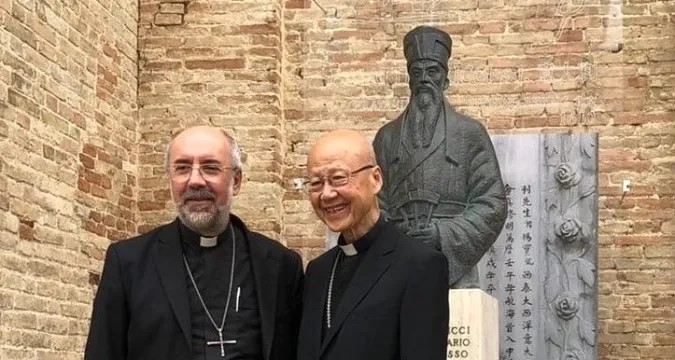
China Bridge (神州橋樑)_2022/Oct
Cardinal Tong in Rome and Macerata

Cardinal John Tong, bishop emeritus of Hong Kong, was in Rome in late August. He attended a meeting for all cardinals held at the Vatican on the recently promulgated apostolic constitution, Praedicate Evangelium [Preach the Gospel], as a response to the call of Cardinal Pietro Parolin, the Secretary of State of the Holy See. Cardinal Tong shared his experience with China Bridge/Sunday Examiner.
During the trip, the first in two years since the onset of the Covid-19 pandemic, Cardinal Tong took the occasion to visit Father Joseph Jing of the Matteo Ricci Study Centre in Macerata, about three hours ride from Rome. He is a visiting professor of the Holy Spirit Seminary College of Theology and Philosophy of the Catholic Diocese of Hong Kong.
In Macerata
On August 23, the day after his arrival in Macerata, Cardinal Tong was received by Bishop Nazzareno Marconi of Macerata. The cardinal thanked the Church in Macerata for its support of the founding and operation of the Study Centre that promotes localisation of the Catholic faith in China.
Macerata is the birthplace of the famed Jesuit missionary to China, Father Matteo Ricci [1552 to 1610]. The cardinal visited a museum dedicated to Father Ricci, his family’s house and a school where he had he studied. Interviewed by the Church media of the, Cardinal Tong said that he appreciated Matteo Ricci’s way of preaching the gospel in China through the aspects of friendship, spirituality, erudition and pastoral enthusiasm.
“Father Matteo Ricci attached importance to making friends, as highlighted in his book, On Friendship. He maintained cordial relationships with the Chinese people, intellectuals and others,” the cardinal said.
On spirituality “he followed Jesus, serving others with love, and bearing the cross without fears to suffering,” he said and with deep love for Our Lady, he dedicated his chapel to Mary, placing a small statue on the altar.
Father Ricci, knowledgeable in theology and philosophy, also had a good grasp of mathematics, physics, astronomy and the use of scientific instruments. “He was willing to share his faith and knowledge with people of the other cultures,” Cardinal Tong noted.
The Jesuit’s missionary zeal was revealed in his writings on catechism, translation of prayer books for the Chinese believers. “He is always regarded as a model of evangelization for the Chinese Church,” Cardinal Tong said.
Accompanied by Father Jing, the cardinal visited neighbouring holy shrines in Loreto and Assisi, where he reflected on the sanctification of St. Francis and prayed for the Church in China and Hong Kong. Afterwards, the cardinal went to Rome for the Vatican’s meeting from August 29 to 30.
At the cardinals’ meeting
Pope Francis and almost 200 cardinals from all over the world met to discuss the implementation of Praedicate Evangelium, outlining reforms on the administrative structure of the Roman Curia and its service to the Church in the world. The document comprises 11 chapters with content on the principles and criteria for the Roman Curia’s service, dicasteries, institutions of justice and finance.
The Holy Father presided over the meeting and led the prayer. The cardinals were assigned into 12 groups in accordance with four languages of Italian, English, French and Spanish. The discussions were lively. At the end of the meeting, the pope announced that 2025 will be a holy year with the theme, Pilgrims of Hope. Then he led all the participating cardinals into St. Peter’s Basilica for a thanksgiving Mass.
Reviewing the history of the Catholic Church, the administrative structure of the Roman Curia has undergone several reforms, as seen in the apostolic constitution of Pope Sixtus V, Immensa Aeterni Dei [1588], the apostolic constitution of Pius X, Sapienti Consilio (1908). Pope St. Paul VI, following the Second Vatican Council, also implemented a reform of the Curia with the apostolic constitution, Regimini Ecclesiae Universae (1967), and Pope St. John Paul II in with the 1988 apostolic constitution, Pastor Bonus, promulgated.
Pope Francis’ Praedicate Evangelium underlines the importance of evangelisation, pointing out that by virtue of baptism, each Christian is a missionary disciple [n.9]. “All the baptised, even the smallest ones, should preach the Gospel by one’s word and deed,” Cardinal Tong said.
The document points out that the reform of the Roman Curia is to be viewed in the context of the Church’s missionary nature so that the administrative structure of the universal Church should also fulfill the mission of evangelisation in its service [n. 3]. In this way, it explains, the creation of the Dicastery for Evangelisation constitutes to the Church’s work of evangelisation and missionary outreach.
Cardinal Tong said that synodality is an essential principle of the Church. It requires an openness and readiness to listen to others’ views, and reflect and pray for the guidance of the Holy Spirit. He said that humility and spiritual conversion are qualities of Christians—clergy or lay people—noting that the document emphasises the involvement of more laypeople in the dicasteries and offices.
Over the past decades, the cardinal has been appointed by the Holy See to several dicasteries and councils, including the Council for the Economy and the Pontifical Council for Interreligious Dialogue. He was happy to see reforms were made with to dicasteries and institutions, like finance. “The Council for the Economy is indeed conducive to promote internationalization and transparency of the operation of the Holy See.” he noted.
Cardinal Tong appreciated the openness shown by other cardinals at the small group and plenary sessions, he said: “Our Church helps us open our hearts and minds to enhance friendly dialogue with people of different religions and cultures, and to promote social progress, harmony and civilisation.”
He said, “If Father Matteo Ricci were alive today, I think he would have promoted such friendly conversations!”
AL/by Annie Lam


 ENG
ENG